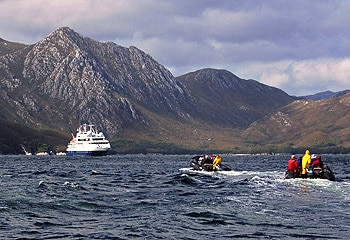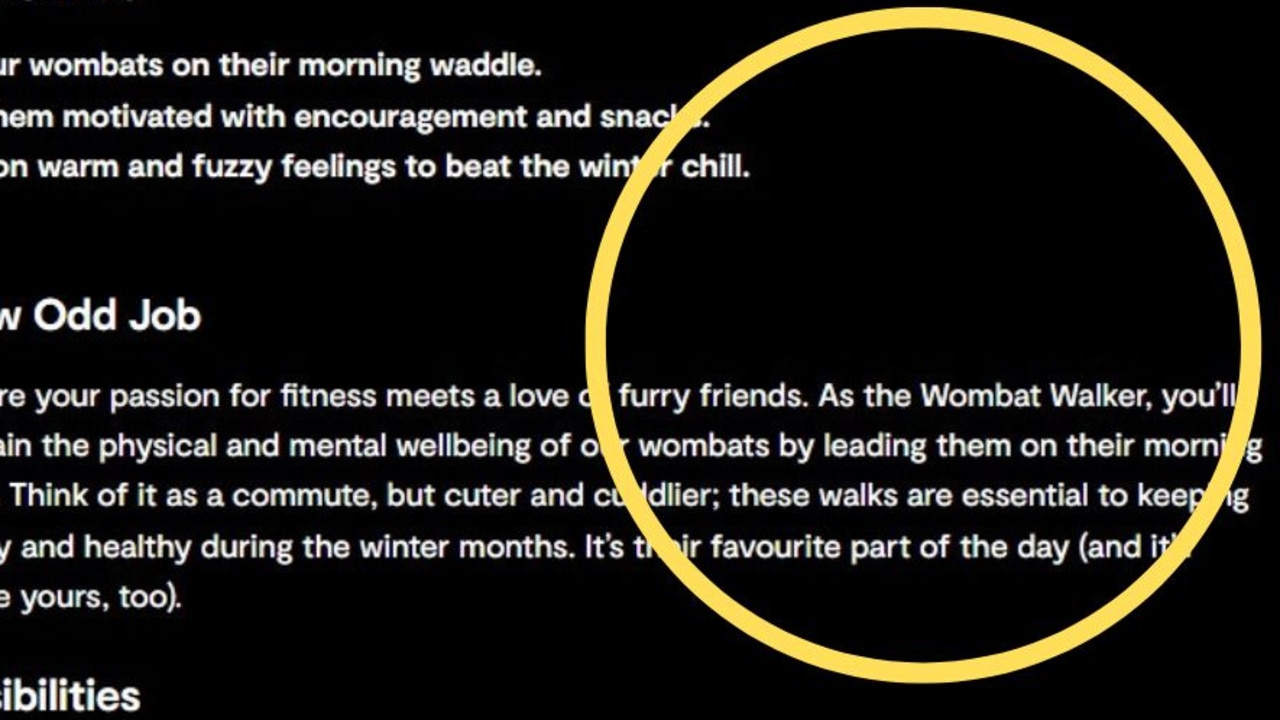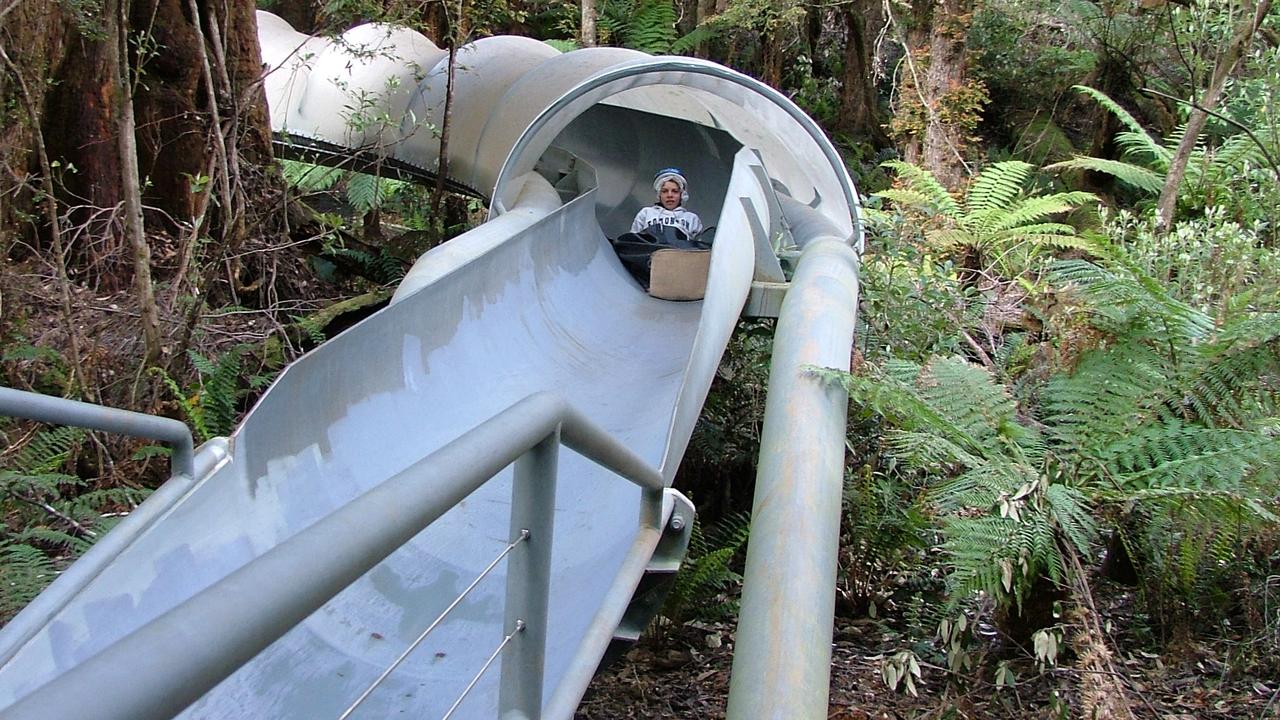Tasmania's high-water marks
A GLAMOROUS gourmet cruise around Tasmania is an adventure that offers a lot more than fine dining, writes Graeme Blundell from the luxurious MV Orion.

COASTING across Hobart's deserted five-lane Tasman Bridge late on this Sunday afternoon, I can see the sharply raked bow and racy, elegant lines of my ship, the German-built MV Orion.
The taxi driver has already checked it out earlier in the day. "Mate, she's more mega-yacht than cruise ship, especially compared to that soulless floating block of flats," he says, waving at the gargantuan Sapphire Princess moored on the other side of No.2 Wharf. "They reckon yours has got an ice-strengthened hull, a stabiliser with retractable fins, and bow and stern thrusters for top cruising dexterity," he adds with a boating aficionado's enthusiasm.
I tell him I'm more interested in cold-climate rieslings, Bass Strait's remote islands and indulgent dairy products because I'm accompanying a gourmet food and wine expedition around Tasmania with Serge Dansereau, celebrity consultant executive chef to Orion. Unimpressed, the driver passionately indicates the fleet of two jet-propelled tenders and 10 heavy-duty motorised Zodiac MK5 inflatable boats harnessed around the Orion's decks. "I'd like to see you drinking chardonnay on one of those," he says, obviously in awe of James Bond-style rubber launches.
I don't pay him or the heavy-duty equipment much heed but a little later, as I explore my stateroom – more luxury hotel suite than cruise liner cabin – a super hi-tech safety harness ("automatic inflation on immersion in water") hits me on the head as I open the cupboard. I feel like a stunt man in an action movie. Is all this really necessary?
I'm aware that on wine and culinary cruises food lovers are expected to indulge in more than just copious menus. But it is rapidly becoming apparent to me, especially after our first briefing session in the Lido Lounge (where the bar is well and truly open), that this cruise is about the expedition experience and that Orion's slogan of "a path less travelled" is more than slick marketing.
It seems that as elegant, intimate (there are only 106 passengers) and comfortable as Orion is, it never loses sight of its purpose as an expedition ship. Team leader Justin Friend, bouncy as one of his Zodiacs, is as qualified in safety, navigation and seamanship as any creation of Patrick O'Brian. The chairs in the Lido Lounge, where he addresses us, are anchored to the floor in anticipation of unruly ocean action.
This cruise is as much about scheelite mines, marauding seals and fragile eco systems as it is about gourmet experiences such as tasting edible kelp, local pepper and honey or the fresh grassy milk from remote King Island dairy herds.
On the first evening, I dine with Dansereau, celebrity grocer Simon Johnson and local winemaker Andrew Hood, of Hobart's Wellington winery (much beloved of Travel & Indulgence's James Halliday), who headline the gourmet agenda. Dominating the discussion is Tasmania's timber-felling industry, its seemingly uncontrollable, labyrinthine influence, and the idea that this kind of eco-based gastronomic tourism has little chance of surviving when all the forests are gone.
I quickly discover that Dansereau's onboard food, prepared by Orion head chef Lothar Greiner, has the virtues of a quietly spoken craft, obviously handmade with integrity, carefully presented but with that touch of magic that lifts his cooking above mere physics and skilled labour. Partnerships between celebrity chefs of Dansereau's ilk and cruise lines such as Orion exemplify today's multifaceted cruise cuisine, as the cruising industry jettisons its notorious late-night buffet and floating smorgasbord image.
And while the simple, almost portion-controlled Dansereau food is delicious, the plus is the mise-en-scene in the sophisticated Constellation Dining Room, which accommodates all guests at a single, unassigned sitting. Communal dining can be a terrible dice throw. But almost half the passengers on this voyage are repeat Orion cruisers, some insisting on the same cabin. By the end of the entree, any awkwardness has evaporated, along with the first glasses of Hood's Wellington Riesling: the Constellation is already one large house party.
Dinner on board is like being part of an enormous foodie-art installation, as one dish follows another, petite, elegant and possessing an understated elan; the waiters are as choreographed and flash as a modern dance company, though hardly esoteric and certainly more entertaining.
The first full day, after a rough night sailing around southern Tasmania, finds us gently moored in remote Port Davey, the entrance to Bathurst Harbour, part of Tasmania's Southwest National Park. It's Zodiac time.
I hunker down in the appropriately monikered Delfinius, named after the small (ranked 69th) northern constellation close to the celestial equator, which, if you catch sight of it, looks remarkably like a leaping dolphin.
I'm taking the two-hour afternoon cruise exploring the area around Bramble Cove, the Breaksea Islands and the eroded Waterfall Bay. It's heavy going and every layer of protective clothing is required as our drivers propel us abruptly across the black, brackish water. There's no food content for today's excursion because we are here to take in the wilderness. Unfortunately, Waterfall Bay is a popular stopping point for passing yachts, and a crude shower of tins and conduit hoses is starkly visible, like graffiti on the white stone. Justin calls the delinquent sailors "grotty yachties" as he spies a fullish bottle of shampoo abandoned on a ledge.
A white-breasted sea eagle swoops down from the seaward side to look at us, feet as heavily scaled as armour, then flies away, wheeling into the wind, its large wings held in a shallow V. There are few other birds in this pristine wilderness apart from several desolate-looking shearwaters.
That night, as we cruise in wild weather along Tasmania's west coast, fires started 18 days ago by lightning are visible in the Reynolds Creek area. Startlingly beautiful, they look like one of Tim Storrier's totemic Burning Rope paintings: the luminous fire line stretches between two points in the darkness and the clouds above quiver against the dark, arrow-straight horizon.
At sea the next day, the lectures and demonstrations begin. Johnson, busy and magisterial, explains the notion of extra-virgin olive oil tasting, showing – with much sniffing, gargling and expiration – the way professional organoleptic assessments come down to the quality of the oil.
His mercantile enthusiasm for a quality product quickly quashes any professional detachment the mischievous providore possesses. He looks at bottles of olive oil like a Victorian botanist studying a rare species, cataloguing and looking for signs of evolution.
He reveals the tricks to test for defects and rancidity, how to recognise the preferred grassy, herbaceous flavours (leaning towards the ripe banana-ish) and the detested fat, flabby flavours of oxidised oil, characterised by an absence of fruit.
"Look for the harvest date on the bottle," he says sternly as we wipe extra-virgin olive oil from our lips. "Fresh is best. Oh, and never trust restaurant olive oil in those little table bottles; they always top them up, so it's usually off."
Later in the cruise, Dansereau, a lively, charming speaker with the weightlifter's shoulders of a serious cook, muses about Tasmanian shellfish, the southern-waters scallop, deep-sea blue mussels and green-lip abalone. Woodchipping killed off aquaculture attempts to commercially farm scallops, he says, but Spring Bay mussels have been a success and Tasmanian abalone constitutes almost half the world's market. There is a serving plate of Spring Bay mussels, a tiny slice of stir-fried abalone, steamed clams and a single plump scallop. "What a thing of nature," the chefmutters, almost tearfully. "I find it quite special."
Winemaker Hood, also a polished performer, is less elegiac about his Wellington wines, a pair of rieslings and a pinot noir, which accompany the dish.
"You have to look deep into a riesling to understand it," he says.
The next day we discover that the much-touted foodie haven, King Island, is a disappointing gourmet destination. Our bus driver is well-meaning but garrulous, the famous cheese factory we've come to see doesn't allow floor visits andour local oyster and crayfish lunch (hours in coming) is taken in a facsimile Swiss chalet built of unpainted lining boards with lacework covering the aluminium windows. "Death by doily," mutters food doyen Leo Schofield, who also happens to be on the cruise.
But the island's main town, Currie, is welcoming and Russell's King Island Butchery has the fattest T-bone steaks I've seen, beef purchased direct from the graziers. "No one eats eye fillet around here, so I leave it all on the bone," says Norma Russell, who is tending the shop.
On the last afternoon, after a presentation by Dansereau, Hood and Johnson, which includes a cheese-tasting of about 20 exotic products, the post-mortems begin, lubricated by Hood's wines.
"The Orion's like travelling in a luxurious private home," says Margaret from Brisbane, as Ronald, everyone's favourite waiter, tops up her glass. The passengers have all become so attached to this ship that if it were broken up you know they would buy the entire fittings of their cabin at auction.
Janine from Perth has the last word. "I couldn't travel on any other cruise ship," she says almost indignantly. "It would be like moving into a bad suburb."
Graeme Blundell was a guest of Orion Expedition Cruises.



